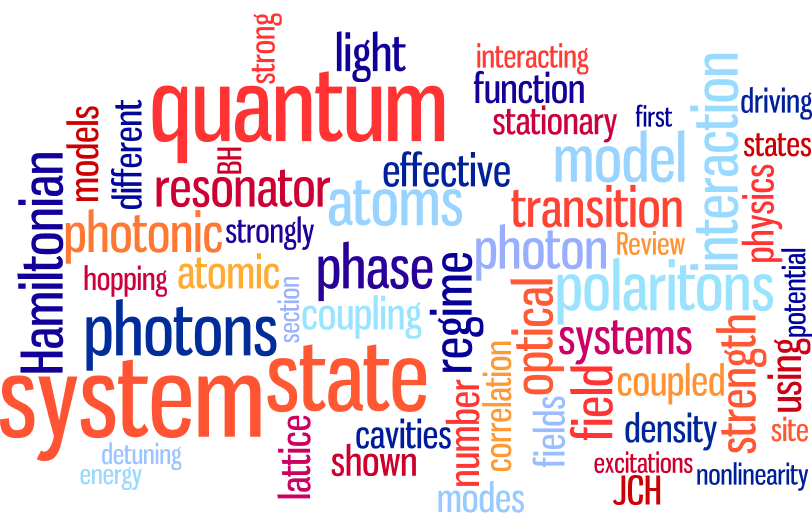Nov 24 2016
Back in 2006, theoretical physicist Dimitris Angelakis was among the first to propose that quantum simulations could be done with photons.
 The review article on "Quantum simulations and many-body physics with light" by CQT's Dimitris Angelakis and alumnus Changsuk Noh references 260 papers and distills to this word cloud. It is published in Reports on Progress in Physics. Credit: Centre for Quantum Technologies
The review article on "Quantum simulations and many-body physics with light" by CQT's Dimitris Angelakis and alumnus Changsuk Noh references 260 papers and distills to this word cloud. It is published in Reports on Progress in Physics. Credit: Centre for Quantum Technologies
Dimitris, now a Principal Investigator at CQT, has teamed up with Changsuk Noh to track what's happened since. The pair have written a review article on "Quantum simulations and many-body physics with light". It was published 4 November in Reports on Progress in Physics.\
A light-bulb moment
In 2006, Dimitris was a Junior Research Fellow at the University of Cambridge, UK. His team along with groups in the UK and Australia realised that light particles could be harnessed to simulate the physics of many-body systems. Such physics governs the properties of real materials.
Quantum simulations have an advantage over experiments done directly on materials themselves: more parameters are tweakable and measurable.
The trick to doing simulations with light is to trap photons in a lattice and then make them interact with each other. Interactions can be mediated by real or artificial atoms like those found in circuit-QED or semiconductor structures. The lattice can also be provided by engineering resonator modes in the device in question – microwave in circuit QED or optical in photonic materials.
The founding works revealed that photons could simulate important phenomena in condensed matter physics, such as Mott transitions. They also introduced the Jaynes-Cummings lattice, now known as the Jaynes-Cummings-Hubbard model.
First experiments
Since the first proposals, there have been many more ideas from many research groups worldwide. Dimitris and Changsuk reference a total of 260 articles in their 38-page review. They include proposals to simulate fractional quantum Hall states, exotic phases of matter such as super-solidity and strongly correlated phenomena such as Luttinger liquids with photons, among others. The article focuses on the major theory results but also outlines recent experimental progress.
"It's nice that the review comes not only ten years after the first papers, but also coincides with the first experiments," says Dimitris. "The experiments took a while because of the technological challenges."
Dimitris hopes the review article will be useful for PhD students starting in quantum optics, condensed matter physics and quantum simulations, and for experts in related areas who are looking to get up to speed on recent developments in the area.
Changsuk was a Research Fellow in Dimitris' group when the pair started work on the review. He is now an Assistant Professor at the Korea Institute for Advanced Study.